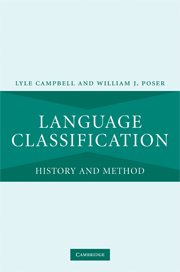Book contents
- Frontmatter
- Contents
- List of figures, tables, and charts
- Acknowledgments
- Preface
- 1 Introduction: how are languages shown to be related to one another?
- 2 The beginning of comparative linguistics
- 3 “Asiatic Jones, Oriental Jones”: Sir William Jones’ role in the raise of comparative linguistics
- 4 Consolidation of comparative linguistics
- 5 How some languages were shown to belong to Indo-European
- 6 Comparative linguistics of other language families and regions
- 7 How to show languages are related: the methods
- 8 The philosophical–psychological– typological–evolutionary approach to language relationships
- 9 Assessment of proposed distant genetic relationships
- 10 Beyond the comparative method?
- 11 Why and how do languages diversify and spread?
- 12 What can we learn about the earliest human language by comparing languages known today?
- 13 Conclusions: anticipating the future
- Appendix: Hypothesized distant genetic relationships
- References
- Index
5 - How some languages were shown to belong to Indo-European
Published online by Cambridge University Press: 22 September 2009
- Frontmatter
- Contents
- List of figures, tables, and charts
- Acknowledgments
- Preface
- 1 Introduction: how are languages shown to be related to one another?
- 2 The beginning of comparative linguistics
- 3 “Asiatic Jones, Oriental Jones”: Sir William Jones’ role in the raise of comparative linguistics
- 4 Consolidation of comparative linguistics
- 5 How some languages were shown to belong to Indo-European
- 6 Comparative linguistics of other language families and regions
- 7 How to show languages are related: the methods
- 8 The philosophical–psychological– typological–evolutionary approach to language relationships
- 9 Assessment of proposed distant genetic relationships
- 10 Beyond the comparative method?
- 11 Why and how do languages diversify and spread?
- 12 What can we learn about the earliest human language by comparing languages known today?
- 13 Conclusions: anticipating the future
- Appendix: Hypothesized distant genetic relationships
- References
- Index
Summary
Babel, Tower of (babel, gate of God), Babylon, the Greek form of the Hebrew word bavel, which is closely allied and probably derived from the Akkadian babilu or “gate of God.” The date of its foundation is still disputed.
(Cornwell 1995)Introduction
There has been considerable confusion recently about how certain languages came to be established as members of the Indo-European family. In this chapter we take up the cases that have been discussed most, setting the record straight and deriving methodological object lessons from these successes. The methods used to establish these as Indo-European languages are quite instructive. Specifically we examine how Hittite, Armenian, and Venetic were shown to belong to the Indo-European family. (For Indo-European more broadly, see Chapters 2, 3, and 4.)
Hittite
Hittite was the language of the ancient Hittite empire in central Anatolia (present-day Turkey), and came to be known from the many clay tablets, written in cuneiform (and the earliest of these in Hieroglyphic Hittite), some from Tel el-Amarna in Egypt, but mostly known from the libraries containing Hittite and other clay documents in Boğaz Köy (today called Boğaz Kale), Turkey. Ultimately these were deciphered. Hittite (and the Anatolian branch generally to which Hittite belongs) proved to be Indo-European, against earlier intuitions. The first substantive claims concerning the Indo-European affiliation of Hittite were made by Knudtzon (1902) (cf. also Bugge 1902 and Torp 1902) in a book devoted to two letters between a Hittite ruler and the king of Egypt found at Tel el-Amarna in Egypt.
- Type
- Chapter
- Information
- Language ClassificationHistory and Method, pp. 74 - 86Publisher: Cambridge University PressPrint publication year: 2008



